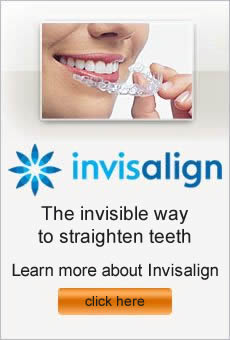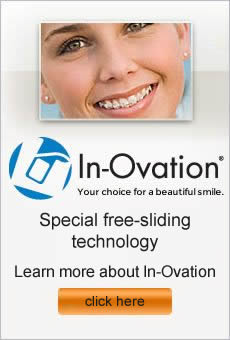The field of orthodontics focuses on the correction of teeth and jaws that are improperly positioned. To become an orthodontist, a dentist must complete an additional two to three years of training after finishing dental school. Orthodontics is recognized as one of several dental specialties by the American Dental Association (ADA).
Check out these interesting tidbits about orthodontics:
• Orthodontists treat over 5 million patients in the U.S. and Canada, more than double the number of patients treated in 1982, the first year that the American Association of Orthodontists (AAO) tracked the number of patients.
• Orthodontic treatment has continued to grow in popularity. Since 1982, the number of patients who seek orthodontic treatment has increased by 115 percent.
• While you can achieve a straight smile at almost any age, most patients begin treatment between the ages of 9 and 14.
• Adults can also benefit from orthodontic treatment. Approximately 20 percent of patients are 18 years or older.
• Treatment time will vary from cases to case, based on individual circumstances. Most orthodontic treatment, however, takes 12 to 36 months, with the average time being 24 months.
• Though metal braces are still a choice, other options exist to straighten your smile. Invisalign clear aligners, lingual braces, and ceramic brackets offer subtle options to correct crooked or crowded teeth.
• The first certified orthodontist in the U.S. was Dr Charles Tweed.
• Pierre Fauchard constructed the first braces in 1728, which consisted of a flat strip of metal that connected to teeth by pieces of thread.
Sherman Oaks, CA orthodontic practice – Mehdi Fotovat, DDS
Though you may have a basic understanding of orthodontic treatment, the lingo can be overwhelming. Knowing the difference between head gear and a retainer will make navigating the waters a little easier. Review the following terms to increase your orthodontic vocabulary.
Appliance
Any device the orthodontist uses to move teeth or reposition your jaw. Appliances can be fixed, like braces and expanders, or removable, like head gear and retainers.
Band
The metal ring placed on your teeth to help hold braces in place.
Biteplate
A removable or fixed device that opens a deep bite by decreasing the vertical overlap of the upper and lower incisor teeth.
Bracket
The ceramic or metal piece cemented to teeth and used as the fastening mechanism for the arch wire.
Braces
Used to align teeth and correct the bite, braces come in various forms, including metal brackets, ceramic brackets, and lingual braces, which are attached behind the teeth.
Diastema
A noticeable space between two teeth, often the front teeth.
Head gear
An orthodontic device used to move your teeth back in your mouth and create room for crowded teeth.
Invisalign aligners
The latest in orthodontic treatment options, Invisalign uses a series of clear, custom trays to gently shift teeth into place. Older teens and adult patients often choose Invisalign over traditional metal braces.
Occlusion
How your upper and lower teeth are aligned and spaced when you bite down.
Palatal Expander
Temporarily placed on the upper arch, a palatal expander helps widen the upper jaw so that the bottom and upper teeth fit together like they should.
We care about your smile at Mehdi Fotovat Sherman Oaks Orthodontist
Orthodontics is the branch of dentistry concerned with prevention and correction involving irregularities of the teeth. In addition to completing dental school, orthodontists must all take an additional two to three years of specialized training. Often, general dentists will refer their patients to the orthodontist if they are concerned about malocclusion, or a bad bite.
Not only are crooked or crowded teeth not very attractive, but they can also contribute to oral health problems. Because routine home care, such as brushing and flossing, is more difficult with crowded teeth, you may be at an increased risk for issues like tooth decay and gum disease. Misalignment can also lead to added stress on the chewing muscles, causing headaches, TMJ dysfunction, or neck, shoulder, and back pain. By adjusting how teeth fit together and how your jaws line up, an orthodontist can straighten teeth and correct your bite.
The only way to determine if you need orthodontic treatment is to visit an orthodontist. During an evaluation appointment, the doctor will take a full medical and dental health history, conduct an oral exam, make impressions of your teeth, and take special X-rays and photographs. With this information, your orthodontist will be able to identify the necessary treatment and complete a comprehensive plan for creating your new, improved smile.
Orthodontic treatment can utilize various appliances and therapies to shift teeth, retrain muscles, and affect jaw growth. Most people think of braces when they hear the word orthodontics, but treatment may also involve head gear, fixed spacers, splints, and palatal expanders. The severity of the issue will determine which methods your orthodontist recommends.
Come in for an evaluation at our orthodontic dental practice in Sherman Oaks, CA – Mehdi Fotovat, DDS
Experts in the proper placement and alignment of the teeth and jaws, orthodontists help patients of all ages achieve straighter, healthier smiles. If you are considering orthodontic care for yourself or a family member, it’s important to select the right provider. Unlike a general dentist, an orthodontist has an additional two to three years of advanced training.
Orthodontists specialize in:
• Aligning and straightening teeth for proper occlusion using fixed and removable appliances
• Closing gaps between the teeth
• Correcting jaw positioning with external appliances like head gear
• Placing braces and other appliances as part of orthodontic treatment
• Treating over bites, cross bites, and deep bites
When it comes to choosing an orthodontist, you should consider several factors:
Convenience
During your orthodontic treatment, you will visit the orthodontist’s office at least once every four to six weeks, sometimes more often. Close proximity to your office or home will cut down on travel time. At the Mehdi Fotovat DDS, we even offer early morning appointments to fit your busy schedule.
Credentials
As you make your selection, evaluate each candidate’s educational background. Ask about continuing education courses. Does the dentist have training in advanced therapies such as Dentofacial Orthopedics or Invisalign? Dr. Fotovat and Dr. Sands, who are trained orthodontists, have received training in Dentofacial Orthopedics. Our doctors work on not only straightening the teeth, but also on creating harmony between the jaws and facial bones with the surrounding structures
Comfort
An important part of your decision making is picking an office and provider your trust. Visit each practice you are considering to get a feel for the personalities and environment. Do you feel welcome and well-treated? It may help to talk with other patients or hear what friends and family have to say about your possible selections before making the final choice.
At Mehdi Fotovat DDS, we offer free orthodontic consultations. Visit our website to see what sets our office apart from other dentists
In most cases, you have probably either had braces, need braces, or know someone with braces. When you need orthodontic treatment, you often receive a great deal of information. Having a basic knowledge about the world of orthodontics will help you make educated decisions for yourself or a loved one.
What is orthodontics?
Simply put, orthodontics is the dental specialty focused on the diagnosis, prevention, and treatment of dental or facial irregularities.
How is an orthodontist different from a dentist?
While all orthodontists are dentists, not all dentists are orthodontists. In addition to successfully completing dental school, orthodontists must also take another two to three years of advanced training.
Can I tell if braces are needed?
The best way to determine if you or a family member should seek orthodontic treatment is through an evaluation with an orthodontist. If you notice buck teeth, an overbite, under bite, or open bite, orthodontic treatment is a likely course of action.
What’s the difference between Phase I and Phase II?
With Phase I, or early interceptive treatment, patients are between 6 and 10 years old, and all their permanent teeth have not yet erupted. Certain problems are easier to treat when children are younger and they are still growing. Also called comprehensive treatment, Phase II happens once all permanent teeth come in and usually involves a full set of braces.
What are my treatment options?
That answer depends on your age and your specific case. Typically, younger children respond well to traditional metal braces. Older teens and adult patients often like less conspicuous choices. Braces with clear brackets and clear aligners like Invisalign can straighten your smile and allow you to maintain a professional image.
Healthy straight teeth at Dr. Fotovat – Burbank Orthodontist – WebBraces.com



